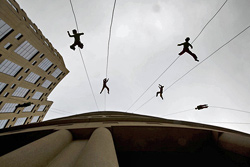Watching the Mountains Dance

Seven people are preparing to jump off the south side of the Vancouver Public Library. About 300 people have begun to gather, watching in anticipation. There are no paramedics on site, no safety nets have been deployed. Tension mounts. Children fidget and start to cry. Groups of friends huddle, clutching their daily dose of Starbucks.
Finally, the music starts and the dancers begin to saunter across the face of the library, held safely in place, mid-air, by rock climbing gear rigged to the top of the building. The dancers’ majestic movements are choreographed by Julia Taffe, artistic director and founder of Aeriosa Dance Company. Occasionally, the performers push off the building, dangling above ground and causing a collective sharp intake of breath. The gravity-defying dancers bounce gracefully off the façade, like a band of ninjas in frilly costumes.
Since its creation in 2001, thousands of Vancouverites have seen Aeriosa perform. They may have caught a show at the Scotiabank Dance Centre (at one of several events off the north or south side of the venue, in its theatre, or in its lobby), off of the Hudson House building in Gastown (during the Vancouver International Jazz Festival), at the Plaza of Nations (during the annual Dragon Boat Festival), in the Vancouver Art Galley (at one of its quarterly FUSE event), or in the Roundhouse Community Centre (as part of the Dance Allsorts series). Most performances are free, and assemble crowds of astonished passers-by.
Different forms of aerial dance exist. Some dancers suspend themselves wrapped in bands of silk; Julia Taffe’s dancers dangle with the support of rock climbing ropes and harnesses, the equipment rigged to the tops of any hard, straight ledges. When Taffe examines a city, she doesn’t just see, say, a park where someone could sit and read a book – she sees a performance space surrounded by sturdy ridges that dancers could rehearse or perform off of. The company portrays the boldness and beauty of the West Coast as an innovative contemporary art that blends the creativity of dance with the power and practicality of rock climbing.
Which is why the Vancouver Organizing Committee for 2010 Olympic and Paralympic Winter Games chose Aeriosa to perform as part of this year’s Cultural Olympiad. For this task, Taffe has commissioned aerial dance artist Amelia Rudolf, artistic director of San Francisco’s Project Bandaloop, to choreograph a full evening piece for 12 dancers at the main branch of the Vancouver Public Library. The work, In Situ, will be accompanied by live music composed by site-specific artists Jocelyn Murdoch and Jordan Nobles of Redshift Music.
“It’s a huge deal for us,” says Taffe. She is poised and elegant, dressed in a sporty fuchsia top, loose black lycra pants, and hiking shoes. Her immaculate olive skin is free of make-up, her shoulder-length tight black curls, stemming from her Jamaican heritage, are loose but not messy. She is 40 years old, but she looks 10 years younger.
To create a work of the scale of In Situ, Taffe received $108,000 of the coveted Arts Partners in Creative Development funding, which is supported by VANOC, 2010 Legacies Now, and municipal, provincial, and federal government bodies. Currently, the future of APCD is undetermined. The funding was set up in 2007 to support the creation of large-scale projects to potentially be presented at the 2010 Games.
“Right from 2003 when they were doing the Celebration 2010 events, I had a sense of the potential for Aeriosa to grow,” she explains, sipping chamomile tea. Knowing that the Winter Games would be showcasing local artists, Taffe has focused Aeriosa on BC-based sites and themes, rather than turning her attention internationally. The local arts community has hotly debated working with VANOC, citing reasons from lack of artistic freedom to sponsorship conflicts. But Taffe refuses to budge on her optimistic outlook. “I’m very, very pleased to be working with VANOC to present In Situ. They’re one of the few organizations that are able to produce a work of this size.” And present it for free, no less.
Taffe’s dance training began at the age of five, when her mother enrolled her in dance, gymnastics, swimming and music lessons to quell the constant energy of her daughter. “There’s a part of me that’s really physical, and I just always had the need to move, and move successfully.”
She grew up across Canada, eventually landing in Winnipeg with her family, and began training with the Royal Winnipeg Ballet and the Winnipeg Contemporary Dancers. Taffe’s energy, physicality and drive led to a serious commitment to dance. “I was one of those people who never wanted to miss a class,” she says. Her determination was enough to land her permission to take the men’s class, in the professional division of the ballet. “That’s when I was such a jock dancer. I would dance all day, then I would take the men’s ballet class, and then I would go to the Y and lift weights… and then I would ride my bike home.”
As she progressed to a professional dance career, the years of discipline and sacrifice became cumbersome and overwhelming. Dancing and training - every day, without fail - became oppressive, and the pressure to take any dance job that came up was stressful. She became drawn to climbing as a less structured way to explore her physicality. Although at first she was concerned about the risks, she gave in to her desire to be in nature. Climbing came to benefit her dancing in unexpected ways: she realized there was much more to lose in climbing than in performance, which led her to develop a new sense of freedom on stage. “Being able to work through my issues as a climber,” she explains, “steadied me and gave me a strength and a calmness that I was able to take back into the studio and on stage, and find that sense of abandonment I was missing.”
Climbing soon became a secondary occupation during the off-season months of her dance career. Taffe began spending the summer climbing season in Vancouver. Her two worlds, dancing and climbing, remained separate until, curious to bring them together, she applied to train with aerial dance choreographer Amelia Rudolph in San Francisco. “It was this really interesting collision of worlds for me.”
Rudolf got Taffe acquainted with the scene in San Francisco, while teaching her about dancing with repelling devices and ropes, occasionally performing off cliffs over the ocean. One of the Taffe’s most memorable experiences working with Rudolf was dancing off the Medlicot Dome, a sheer rock face in the Tuolumne Meadows in Yosemite Park. There, in the middle of the wilderness, 20 dancers climbed a gulley through the woods, set up their gear and staged a performance with the park as their backdrop. “That was really good. It was my first experience with Amelia, learning different choreography, checking out different natural sites.”
The next time she saw Rudolph, Taffe was “retired” from dance and working as a guide in Banff, Alberta. Rudolph was at the Banff Centre staging a vertical dance workshop with two French choreographers; delighted to see each other again, she asked Taffe to join the company. She accepted, and worked with Project Bandaloop for the next two years, touring internationally.
In 2001, The Dance Centre issued a call for proposals as part of the opening of its new facilities on the corner of Granville and Davie streets. Taffe pulled together some dancers and climbers, and submitted a successful proposal. Aeriosa was born. Afterwards, Taffe continued to find opportunities to perform. Over the years, she has trained a stable of dancers, a challenging task given the specificity of her work. “The difficulty with pretty much every single dancer is I have to train them from scratch with the safety equipment, and they also have to figure out if they’re the type of person who wants to hang off a building.”
Besides the work itself being very physically challenging (“It’s like Pilates on crack”), dancers have to discover whether or not they’re physically suited to the work. For Aeriosa, the requirements and perception of safety is paramount. “We don’t want to be doing a rescue off a building because someone has a shoulder that dislocates easily,” she explains, “I really want to avoid the perception that we’re doing stunts.” To establish a culture of safety, Aeriosa’s riggers are trained in improvised rescue, and the company spends much of its time researching preventative measures. The safety preparedness is ritualistic – protecting edges, building proper anchors, creating a fall protection plan, and providing special training for the dancers.
In Situ will be performed by a mix of local dancers and Aeriosa alumni, strengthening Taffe’s vision of offering Aeriosa’s performers employment over longer periods of time. “The more I can keep them employed and training, the better the work’s going to be,” says Taffe. Like most BC-based dance companies, Aeriosa only receives project-based funding, and is not capable of retaining dancers on a regular basis. Every time she wants to mount a show, she hopes that previously trained dancers will be available, or else finds new ones and starts from scratch.
As a mountaineer, and an artist, Taffe is ready for any catastrophe, including the imminent cuts to the provincial arts budget. She considers herself an educated risk-taker in her professional and personal life. “I’m not worried about it, because if I were I wouldn’t be able to function. I’m totally prepared at anytime for everything to come crashing down around me. I’ll just come up with another plan,” she states. “Say the funding gets cut off and there are no more grants to explore in the studio. Well, there’s a big world out there.”
The dancers float above the audience, thrusting themselves into the ether. The sky is clear, and the North Shore Mountains are mirroring the north face of the towering library. The dancers sway, and we watch them, amazed at their seemingly effortless movement on this cold, crisp day.



